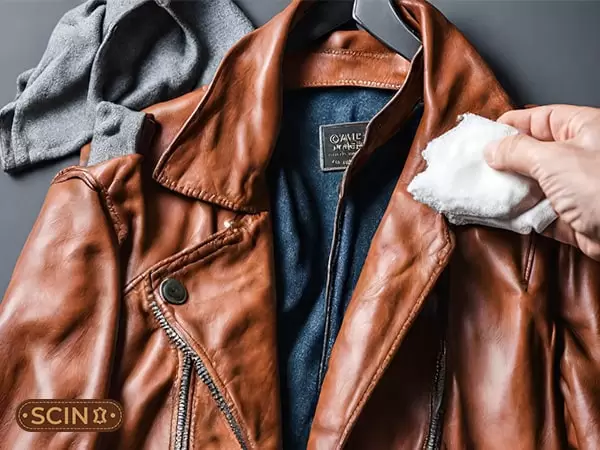A leather jacket is a timeless fashion statement and an investment. To make sure your leather jacket remains supple, resilient, and as stunning as new, proper conditioning is key. Furthermore, conditioning a leather jacket isn’t just about preserving its appearance; it’s also about maintaining its durability and longevity. Let’s dive into the steps to condition your leather jacket effectively, keeping it supple, soft, and resistant to the test of time.
Understanding Your Leather Jacket
Leather Types
- Full-Grain Real Leather: Known for its durability and natural appearance.
- Top-Grain Real Leather: Slightly altered surface, still robust.
- Genuine Leather: Made from lower layers, may require more conditioning.
- Suede/ Nubuck: Soft and delicate, needing specific care.

Identifying the Condition of Your Leather Jacket
- Check for dryness, cracks, stiffness, or discoloration.
- Observe any stains or marks that need pre-cleaning.
Pre-Conditioning Steps
Clean the Leather Jacket
- Use a soft-bristled brush or a damp cloth to remove surface dust and dirt.
- For stains, use a leather cleaner suitable for your leather jacket type.
Start by gently cleaning your leather jacket to remove any dirt or debris. Also, use a mild leather cleaner or a mixture of water and a few drops of mild dish soap.
Next, dampen a soft cloth with the solution and wipe down the leather jacket surface, paying extra attention to areas with stains or dirt buildup.
Test the Leather Conditioner
Apply a small amount of leather conditioner on a hidden area to ensure compatibility and no discoloration or damage to the leather. Moreover, follow the conditioner’s instructions for the best results.
Conditioning Your Leather Jacket
Choose the Right Conditioner
- Opt for a high-quality leather conditioner recommended for your specific type of leather jacket.
- Consider natural products like beeswax or coconut oil for a DIY approach.
Application Process
Step 1: Apply the leather conditioner using a clean, soft, lint-free cloth or sponge.

Step 2: Apply a small amount of leather conditioner and rub it into the leather surface in a circular motion. Remember to focus on one section at a time, ensuring even coverage.
Step 3: Pay extra attention to places prone to wear and tear. However, don’t forget to apply conditioner to seams, pockets, and any crevices where the leather folds because these areas are prone to drying out faster and may benefit from extra attention.
Step 4: Allow the leather conditioner to absorb into the leather jacket surface for the recommended time specified by the product instructions. Moreover, this typically ranges from 15 minutes to a few hours. Also, keep in mind that patience is key to achieving the best results.
Wiping Off Excess
After the conditioner has been absorbed completely, use a clean, dry cloth to gently wipe off any excess product. Furthermore, ensure that no residue remains on the leather surface to avoid a sticky or oily feel.
Allow Drying Time
- After cleaning, allow your leather jacket to air dry completely in a well-ventilated area. Moreover, avoid exposing it to direct sunlight or heat sources as this can cause the leather to become brittle.
- Avoid wearing or storing the leather jacket until it’s completely dry or the surface of your leather jacket might crack over time, losing its timeless allure.

Maintenance Tips
Spot Cleaning
- Promptly attend to any spills or stains using a recommended leather cleaner.
- Blot stains gently without rubbing to prevent further damage.

Regular Conditioning
Conditioning a leather jacket could be an annual practice for you if you live in extremely cold weather and extensively use your favorite leather jacket. Ideally, it is recommended to aim for conditioning your leather jacket every 3-6 months, depending on usage and climate because conditioning maintains the leather‘s flexibility and prevents drying or cracking of surface. However, conditioning a leather jacket may vary by the type and condition of your leather jacket.
Storage
- Store your leather jacket in a breathable garment bag, away from moisture and direct sunlight.
- Avoid plastic covers as they can trap moisture and cause mildew.
- Hang your leather jacket on a padded or wide hanger to maintain its shape. Also, avoid using wire hangers, as they can create creases and distort the form of the leather jacket.

Do’s and Don’ts
Do’s
- Use a soft cloth or sponge for application to prevent scratches on the leather surface.
- Test the leather conditioner on a small area before full application.
- Follow the manufacturer’s guidelines for specific care instructions regarding your leather jacket.
Don’ts
- Never use harsh chemicals or household cleaners that can damage the leather surface.
- Do not over-saturate the leather with conditioner; a little goes a long way.
- Never skip the patch test; it helps avoid potential damage to your leather jacket.
